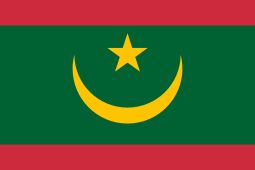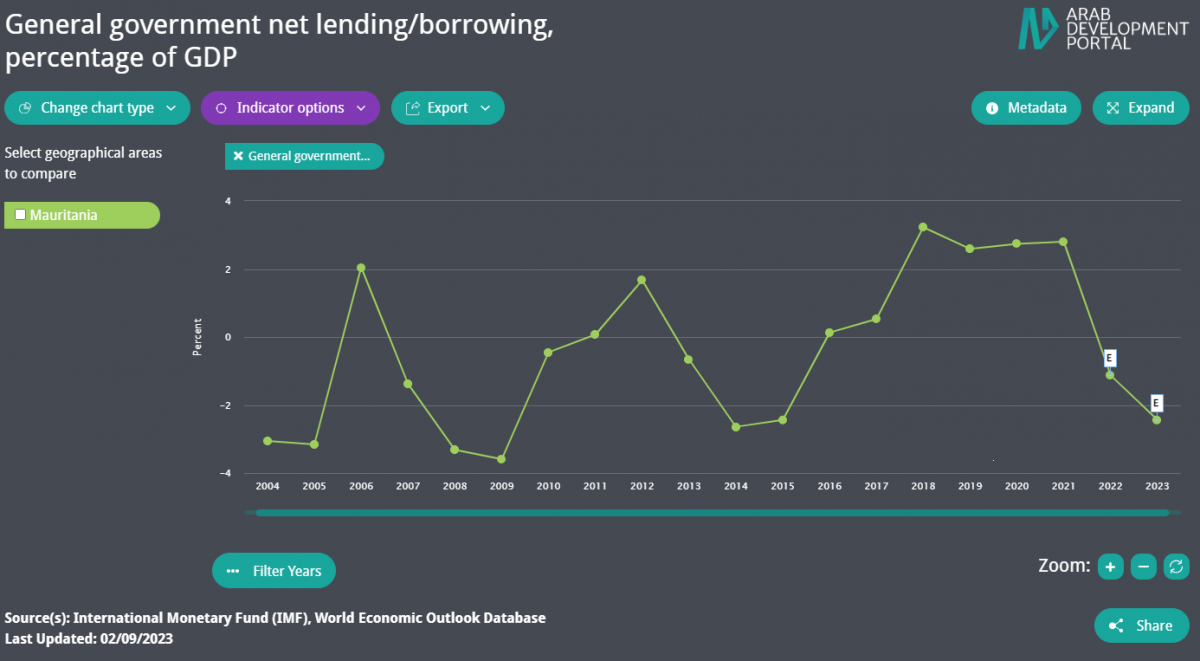 Mauritania
Mauritania
Mauritania is the fifth-largest country in the Arab region, with an estimated population of 4.67 million in 22022. It is growing at an annual rate of 2.6 percent, and life expectancy at birth averages 64.7 years.[1] Concerning urbanization, 56.9 percent of Mauritania’s population resides in urban areas, almost equal to the world average of 57 percent in 2022.[2] Mauritania experiences high levels of food insecurity, the size of the food-insecure population was estimated to be 440,765 people, or 10% of the total population in 2022.[8] Regional conflict drove refugee flows into Mauritania which hosted 100,981 registered refugees of which 98 percent of them are from Maliat by the end of 2022.[4]
Mauritania is a lower middle-income country in North-western Africa, with a Gross National Income (GNI) per capita (PPP constant 2017 USD) of $5,343.5.[5] Growth increased from 2.4% in 2021 to 7.1% in 2022 supported by higher exports on the demand side, and the expansion of the agricultural and extractive sectors on the supply side. In 2023, economic growth is projected to decelerate to 4.3%.[6] The overall fiscal balance registered a deficit of 3 percent of GDP in 2022 compared to a surplus of 2.2% of GDP in 2021, due to higher transfers and lower revenues. The debt-to-GDP ratio remained stable in 2022 and around 44.7%. The annual average inflation reached 9.5% in 2022 and is expected to decrease to 6.0% in 2023, as external pressure on prices subsides.[6] Moreover, Mauritania continues to face several development challenges and considerable risks, given the inefficient use of revenues derived from natural resources, limited diversification, and poor infrastructure.[6]
Water and food insecurity are among the main challenges hindering the country’s growth. According to the results of the Inter-Agency food security analysis conducted in March 2022, some 878,921 people (20% of the population) were food insecure during the lean period (June-September 2022). There were 136,254 malnourished children, including 103,514 (6%) in moderate acute malnutrition and 32,740 in severe acute malnutrition, compared with 116,000 children in 2020. [11] Poverty remains widespread in Mauritania, with 50.6 percent of the Mauritanian population living in multidimensional poverty according to the 2021 Human Development Report, as well as 31 percent of the population living below the income poverty line of PPP $ 1.90 a day.[9]
Labor force participation in Mauritania has been dropping over the past three decades, reaching 40.84 percent in 2022, down from 46.48 percent in 1990. Along the same lines, youth unemployment was high at 21.9 percent in 2022, particularly for women at 26.54 percent. At the sectoral level, 29.5 percent of the workforce works in agriculture, compared to only 18.86 percent in industry.[10]
Mauritania has lagged in education, where the gross tertiary enrolment rate was 5.87 percent, compared to a regional average of 40.3 percent in 2020. Nevertheless, the gross primary enrolment rate increased from 83 percent in 2000 to 100.4 percent in 2019 then dropped back to 94.3 percent in 2020, with a Gender Parity Index (GPI) of 1.07.[5]
This overview was last updated in November 2023. Priority is given to the latest available official data published by national statistical offices and/ or public institutions.
Sources:
[1] Population Division of the Department of Economic and Social Affairs of the United Nations Secretariat. 2023. World Population Prospects. [ONLINE] Available at: https://population.un.org/wpp/ [Accessed 23 October 2023].
[2] Population Division of the Department of Economic and Social Affairs of the United Nations Secretariat. 2023. World Urbanization Prospects. [ONLINE] Available at: https://population.un.org/wup/ [Accessed 23 October 2023].
[3] United Nations International Children’s Emergency Fund (UNICEF). 2021. Humanitarian action for children: Mauritania. [ONLINE] Available at:
https://www.unicef.org/media/87276/file/2021-HAC-Mauritania.pdf [Accessed 28 February 2021].
[4] United Nations High Commissioner for Refugees. 2023. UNHCR data. [ONLINE] Available at: https://www.unhcr.org/what-we-do/reports-and-publications/unhcr-data [Accessed 15 October 2023].
[5] The World Bank. 2023. World Development Indicators. [ONLINE] Available at: https://databank.worldbank.org/data/source/world-development-indicators [Accessed 23 August 2023].
[6] The World Bank. 2023. The World Bank in Mauritania, Overview. [ONLINE] Available at: http://www.worldbank.org/en/country/mauritania/overview [Accessed 28 November 2023].
[7] International Monetary Fund. 2023. World Economic Outlook. [ONLINE] Available at: https://www.imf.org/en/Publications/SPROLLs/world-economic-outlook-databases#sort=%40imfdate%20descending [Accessed 24 October 2023].
[8] UNOCHA. 2023. Food Insecurity - DREF Operation-Final Report [ONLINE] Available at: https://reliefweb.int/report/mauritania/mauritania-food-insecurity-dref-operation-final-report-ndeg-mdrma013#:~:text=The%20size%20of%20the%20food,%E2%80%9D%20phase%20(IPC%203). [Accessed 28 November 2023].
[9] United Nations Development Programme (UNDP). 2023. Human Development Index. [ONLINE] Available at: https://hdr.undp.org/data-center/documentation-and-downloads [Accessed 25 October 2023].
[10] International Labor Organization. 2023. ILO stat [ONLINE] Available at: https://ilostat.ilo.org/ [Accessed 23 September 2023].
[11] UNOCHA. 2023. Mauritania: Drought - Jun 2022 [ONLINE] Available at: https://reliefweb.int/disaster/ot-2022-000240-mrt#:~:text=The%20country%2C%20mainly%20arid%2C%20is,the%20price%20of%20basic%20foodstuff. [Accessed 28 November 2023].
Data Highlights
-
The net lending/ borrowing as a percent of GDP returned in 2023 (-2.44 percent) to almost the same value registered a decade ago in 2014 and 2015
